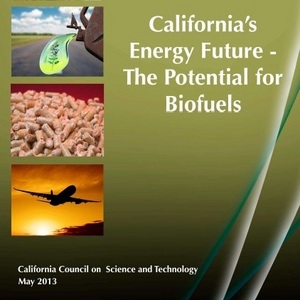Cellulosic, drop-in fuels needed to meet Calif. GHG goals

California Council on Science and Technology
June 7, 2013
BY Erin Krueger
The California Council on Science and Technology has released the final report associated with its California’s Energy Future project, which seeks ways in which the state can meet its mandate to reduce greenhouse gas emissions to 80 percent below 1990 levels by 2050. A key finding of the report is that substantial amounts of low-carbon biofuels will be required to meet California’s emission reduction goals, even when the researchers integrated optimistic increases in efficiency, electrification and the implementation of other renewable energy sources into its analysis.
The report, titled “California’s Energy Future—The Potential for Biofuels,” focuses on assessing the potential for biofuels to contribute to the energy needs of the state, primarily in transportation. According to the CCST, the degree to which biofuels may be able to assist California in meeting its emission reduction goals depends on how overall demand for fuels rises for falls by 2050.
To complete the analysis, the researchers investigated six scenarios involving two demand cases and three supply cases. According to the report, the first scenario was a “stress test” case where biofuels were used to meet a business-as-usual demand case of 44 billion gallons of gasoline equivalent. This demand level is nearly double of that in 2005.
Advertisement
The business-as-usual fossil fuel mix includes an E10 blend for gasoline and a B20 blend diesel. The business-as-usual case was compared to two future scenarios. As part of the near-term scenario, cellulosic ethanol was blended into gasoline at an 85 percent inclusion rate. Diesel also consisted of a 85 percent biofuel blend. The far-term scenario featured biomass-based drop in biofuels blended with 10 percent cellulosic ethanol and 10 percent biodiesel.
The near-term case was determined not to meet the state’s emissions reduction targets as emissions reductions were found to be in the 15 percent to 53 percent range, compared to 2005 emissions levels. However, the analysis showed that the far-term scenario could “maybe” meet the goal, as the scenario resulted in an estimated 55 percent to 109 percent emissions reduction. When efficiency and electrification were introduced into the scenario, the near-term case resulted in emissions reductions of 50 to 85 percent, resulting in a “maybe” for meeting state goals. However, when these factors were included in the far-term scenario, state emissions reductions goals were found to be met, as the scenario’s emissions reductions jumped to 85 to 120 percent.
California state policy also sets a goal of producing 75 percent of the biofuels it consumes from in-state resources. Analysis was performed using two scenarios; one assuming 40 percent recovery of residual biomass from agricultural and forestry activities, with no growth in municipal waste and very little production of purpose-grown energy crops, the other assuming 66 percent recovery of residues, growth of municipal waste, extensive construction residues, and an increase in dedicated energy crops. Even when efficiency and electrification variables were added to the analysis, neither scenario was able to meet the policy goal of 75 percent in-state production of biofuels.
The conclusion of the analysis states that next-generation biofuels can meet the greenhouse gas emissions reduction goals, but that deep replacement of fossil fuels through the implementation of low-carbon cellulosic ethanol, advanced drop-in biofuels and a reduction in demand is required.
Advertisement
"California can supply a substantial amount of biofuel from in-state resources through the use of residual biomass and purpose-grown energy crops," said lead author Heather Youngs, a senior fellow at the Energy Biosciences Institute at UC Berkeley. "However, judicious use of such feedstocks will be required to obviate long-term sustainability concerns and maximize efficient resource management." Youngs co-authored the study with EBI Director Christopher R. Somerville, Philomathia professor of alternative energy at UC Berkeley.
"Technologies can be deployed to produce low carbon biofuels to meet demand by 2050,"Youngs added. "Whether this deployment occurs in California depends on many factors, including the biomass supply and economic considerations."
A full copy of the report is can be downloaded from the CCST website.
Related Stories
The U.S. EPA on July 8 hosted virtual public hearing to gather input on the agency’s recently released proposed rule to set 2026 and 2027 RFS RVOs. Members of the biofuel industry were among those to offer testimony during the event.
The U.S. exported 31,160.5 metric tons of biodiesel and biodiesel blends of B30 and greater in May, according to data released by the USDA Foreign Agricultural Service on July 3. Biodiesel imports were 2,226.2 metric tons for the month.
The USDA’s Risk Management Agency is implementing multiple changes to the Camelina pilot insurance program for the 2026 and succeeding crop years. The changes will expand coverage options and provide greater flexibility for producers.
President Trump on July 4 signed the “One Big Beautiful Bill Act.” The legislation extends and updates the 45Z credit and revives a tax credit benefiting small biodiesel producers but repeals several other bioenergy-related tax incentives.
CARB on June 27 announced amendments to the state’s LCFS regulations will take effect beginning on July 1. The amended regulations were approved by the agency in November 2024, but implementation was delayed due to regulatory clarity issues.
Upcoming Events










